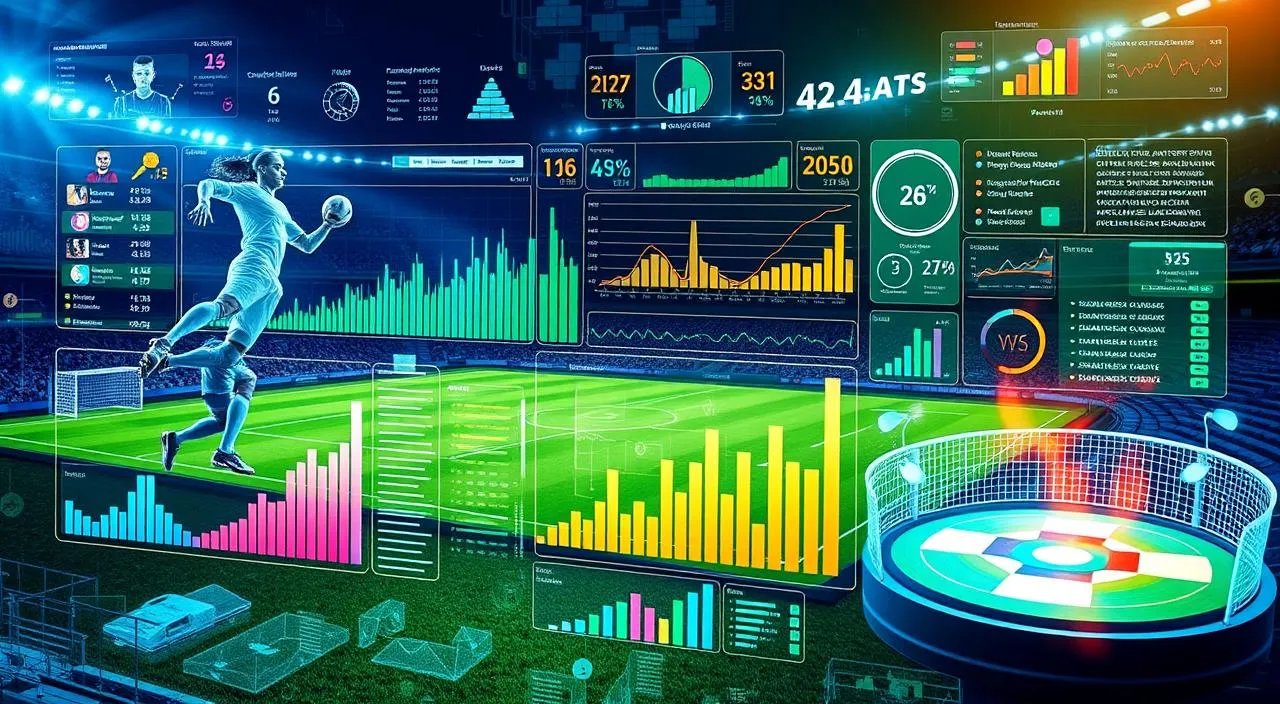In the world of professional sports, winning can be just inches away. Teams are now using data analytics to get ahead. The global sports analytics market is expected to hit $4.5 billion by 2025, up from $800 million in 2016.
This shift is changing how teams pick players, plan strategies, and connect with fans.
Welcome to the world of sports analytics. Here, numbers and algorithms unlock the secrets of sports. In this guide, we’ll look at how data is changing the game. We’ll cover player evaluation, team strategy, fan engagement, and more.
Get ready to see the impact of data on sports. We’ll explore the sports wonk’s dream: fodder for New York Times readers.
Key Takeaways
- The global sports analytics market is poised to reach $4.5 billion by 2025, a significant increase from just $800 million in 2016.
- Data-driven insights are transforming the way teams evaluate talent, optimize strategies, and engage with their passionate fan bases.
- Sports analytics is revolutionizing player evaluation, team strategy, and fan engagement, providing a competitive edge for savvy teams.
- The article will explore the latest trends and innovations in the sports analytics industry, appealing to both sports enthusiasts and data-driven professionals.
- The New York Times readership represents a prime target audience for this comprehensive guide on the power of data in the world of sports.
Unleashing the Power of Data Analytics in Sports
Data analytics has changed the game in sports, giving teams a competitive advantage like never before. It uses data-driven insights and statistical analysis to change how talent is evaluated and players are trained. This approach is key to success.
Data-Driven Insights for Competitive Advantage
The old days of relying on gut feelings are over. Now, sports analytics is a key tool. It helps teams find hidden patterns and make smart decisions, giving them an edge over rivals.
Data analytics has changed how teams scout players and plan their games. With advanced metrics, they can understand player and team dynamics better. This leads to better rosters and game plans.
Statistical Analysis and Advanced Metrics
The core of this change is statistical analysis. Sports analytics tools help teams find valuable insights in lots of data. This includes player stats, game logs, and even video analysis.
| Metric | Description | Competitive Advantage |
|---|---|---|
| Shooting Efficiency | Measures a player’s shooting skill, considering shot location and difficulty. | Helps find and improve players with great shooting skills, key for scoring. |
| Defensive Rating | Looks at a player’s defensive impact, including steals, blocks, and rebounds. | Helps build strong defenses and find players who can stop opponents. |
| Possession Efficiency | Checks how well a team uses each possession, considering turnovers and second chances. | Helps teams improve their offense, reduce mistakes, and create more chances to score. |
By using data analytics and advanced metrics, sports teams can stay ahead. They gain a competitive advantage in a world driven by data.
Predictive Modeling: The Future of Player Evaluation
In the world of sports, teams are now using predictive modeling and machine learning to evaluate players. This is a big change from relying on gut feelings and personal opinions. Today, data is key in finding and developing sports talent.
Machine Learning Techniques for Talent Scouting
Teams use advanced algorithms to look at lots of data. This includes player stats, game footage, and more. Machine learning helps find patterns that humans might miss. It helps teams find new talent and see a player’s future success.
- Predictive models look at many things to guess how well a player will do. This includes physical skills, technical abilities, and how well they fit into different teams.
- Scouting tools powered by machine learning can find talented players from all backgrounds. This makes sports more diverse and inclusive.
- By always improving these models and adding new data, teams can get even better at finding talent.
Injury Prevention and Performance Optimization
Predictive modeling is changing how teams prevent injuries and improve player performance. Advanced analytics and machine learning help spot injury risks and create training plans. This way, players can perform their best on the field.
- Models can look at a player’s past injuries, how they move, and their training to guess if they might get hurt again. This lets teams act early and create special recovery plans.
- Performance models help teams make training plans that fit each player’s needs. This boosts their physical and mental readiness.
- Wearable tech and real-time data tracking make these systems even better. Teams can make quick, smart decisions to help players reach their full ability.
The sports world is getting more into data and machine learning. This means player evaluation will keep getting better. Teams will find the best players and make them perform their best. This will make sports more competitive and exciting.
fodder for a sports wonk nyt
In the fast-paced world of sports, the New York Times crossword puzzle stands out. It’s a unique mix of fun and brain work for sports fans. The “Fodder for a Sports Wonk” crossword is a favorite, blending sports smarts with wordplay.
Every week, it attracts a big following among sports data fans. The clues are tricky, testing your knowledge of sports. You’ll need to remember player names, team histories, and more. It’s a challenge that shows who’s a true sports wonk.
| Metric | Value |
|---|---|
| Founding Year of NYT | 1851 |
| First Sports Section in NYT | 1896 |
| Number of Sports Covered | Over 30 |
| Annual Revenue from Sports Section | Estimated at $100 million |
| Social Media Followers | Over 4 million |
| Subscription Base | Over 7 million digital subscribers |
| Number of Annual Articles | Approximately 3,000 |
| Global Reach | Coverage in over 50 countries |
The crossword is more than just a challenge. It brings fans together, creating a sense of community. People compete to solve it first and share tips online. It’s a fun way to show off your sports knowledge.
In today’s sports world, where data is key, the crossword is a special tradition. It shows the lasting appeal of sports trivia. As the New York Times keeps innovating, this crossword remains a favorite among sports fans.
Redefining Team Strategy with Data Science
Data science is changing how sports teams plan and make decisions. Coaches use advanced tools to get ahead, changing game planning and in-game choices. This shift is making sports more strategic and competitive.
Game Planning and In-Game Decision Making
Data science is key in game planning. Teams use it to find patterns and insights from past games. This helps them create strategies that play to their strengths and weaken their opponents.
It also changes how teams decide during games. Coaches can adjust plans in real-time with data. They make choices based on the game’s flow, aiming for the best outcome.
Player Deployment and Lineup Optimization
Data science also shapes how teams use their players. Coaches look at performance, injuries, and team chemistry to set lineups. This ensures the team works best together, giving them an edge.
| Key Benefits of Data-Driven Team Strategy | Improved Outcomes |
|---|---|
| Enhanced game planning and in-game decision making | Increased win rates and championship chances |
| Optimized player deployment and lineup configurations | Boosted team performance and competitive edge |
| Predictive analytics for talent scouting and injury prevention | Lower risk and better resource use |
As sports embrace data science, teams using these tools will lead the way. They will set new standards for strategy and performance in sports.
Fan Engagement in the Digital Era
In today’s digital world, sports groups are finding new ways to connect with fans. They use social media and digital marketing to build strong bonds. This helps teams and leagues reach out to their supporters in meaningful ways.
Social Media and Digital Marketing Strategies
Sports teams and leagues use social media like Twitter, Instagram, and Facebook to talk to fans. They share updates, highlights, and special content. This gives fans a rich experience.
They also use data to make their content more personal. By knowing what fans like, they can offer experiences that feel just right. This makes fans feel closer to the team and builds loyalty.
Data-Driven Fan Experience Enhancement
- Leveraging advanced analytics to understand fan demographics, interests, and consumption patterns
- Utilizing predictive modeling to anticipate fan needs and offer personalized in-stadium amenities and content
- Integrating cutting-edge technologies like augmented reality (AR) and virtual reality (VR) to enhance the game-day experience
- Deploying chatbots and AI-powered virtual assistants to provide seamless customer support and streamlined ticket purchasing
By diving into the digital world, sports groups are changing how they engage with fans. They offer experiences that are both immersive and tailored to what fans want. This meets the high standards of today’s sports fans.
| Key Digital Engagement Metrics | Industry Benchmarks |
|---|---|
| Social Media Followers | 10 million+ (Top Performing Teams) |
| Engagement Rate (Likes, Comments, Shares) | 3-5% (Highly Engaged Audience) |
| Website Visits | 1 million+ Monthly (Top Sports Websites) |
| Mobile App Downloads | 1 million+ (Top Performing Apps) |
“The future of sports fan engagement lies in the seamless integration of digital technologies and data-driven insights to create truly personalized, immersive experiences that captivate and inspire the next generation of sports enthusiasts.”
Emerging Trends in the Sports Analytics Industry
The sports analytics field is changing fast, thanks to more data and new tech. Teams and leagues are using data to get ahead. Predictive modeling and machine learning are key, helping with talent, injuries, and player performance.
But it’s not just about data. The industry is also focusing on fan engagement. Teams are using social media and digital marketing to connect with fans. This helps them understand and meet fan needs better.
The future looks bright for sports analytics. With new tech and data methods, we can expect big changes. These changes will bring better competition, fan experiences, and insights into sports.
FAQ
What is the focus of this article?
This article looks at how data analytics is changing sports. It talks about using advanced metrics and predictive models. These tools help teams evaluate players, plan strategies, and engage fans better.
How are teams and organizations leveraging data-driven insights?
Teams use data to make smarter choices. They look at player performance and team strategy. Advanced metrics help them stay ahead of the game.
What is the role of predictive modeling in player evaluation?
Predictive modeling is key in evaluating players. Teams use it to find and develop new talent. It also helps prevent injuries and improve player performance.
What is “fodder for a sports wonk nyt”?
“Fodder for a sports wonk nyt” is a crossword puzzle in the New York Times. It’s for sports fans who love data. It offers fun content for those into sports analytics.
How are data-driven insights redefining team strategy?
Coaches use analytics to plan games and make decisions during play. They also adjust player positions to improve team performance.
How are sports organizations enhance fan engagement in the digital age?
Sports teams use social media and digital marketing to reach fans. They also use data to improve the fan experience. This includes better in-stadium amenities and personalized content.
What are the emerging trends in the sports analytics industry?
The article talks about the growth of data analytics in sports. It mentions the rise of predictive modeling and efforts to engage fans through data. It looks at the future of sports analytics.

My name is Jakir, I am a content writer, content creator, I give business, sports, finance, trending news and I have 10 years of experience in this and this is my blog goldennews24.com.










